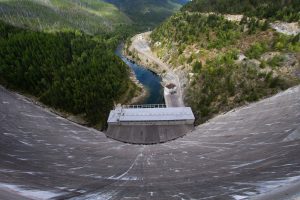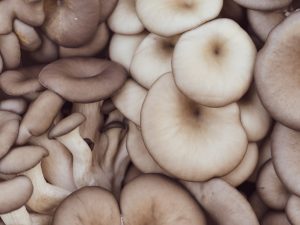4 Ways Mushrooms Can Save the Planet & Shape Our Future
May 25, 2021
Why does a mushroom get invited to all the parties?
Because it’s a fun-gi!
…and because mushrooms have countless uses that we are only beginning to discover, many of which can (and probably will) save our planet.
In 1928, Alexander Fleming discovered penicillin, which is an isolated antibiotic substance derived from Penicillium notatum, a fungus!
This mysterious substance went on to save millions of lives in WWII and millions more since. If this modest mushroom had not accidentally been discovered as a cure to basic infections, our life expectancy today might have been significantly lower.
Fungi, which are in a separate kingdom from plants and animals, have received considerably less attention in the arts and sciences throughout history. Today they are receiving the attention they deserve and the results are looking good.
As of recently, scientists have begun to better understand the mechanics of the root-like structure of Mycelium. This vast underground network of mushroom roots help the fungi to communicate with one another and transport nutrients to areas of need. Harnessing the power of mycelium has proven to be an effective way to use the power of mushrooms to our benefit.
Due to the multifaceted nature of climate change, there isn’t a single answer to how we can solve it. Rather, it requires many different solutions to fix the problem.
Here are a few of the ways mushrooms can save our planet:
Building Material:
Concrete is the most widely used man-made material in existence. It is second only to water as the most-consumed resource on the planet. According to one study, cement accounts for 8% of the world’s carbon dioxide (CO2) emissions. With cement being such a massive emitter of greenhouse gases, it seems clear that we must find an alternative material.

One answer to this is using the fast growing and malleable mycelium network, combined with agricultural waste or byproducts . The process of making building materials using mycelium involves also using products from other industries such as wood shavings, or agricultural by-products. The mycelium acts as a glue-like substance that bonds the by-product material together to create a durable and lightweight block. This can be used to build structures, home insulation, and sound proofing material. Though the use of this material is still in its infancy and it may be a while until we see this material take over our concrete jungles.
Packaging Material:
Packaging for items you might receive from shipping companies like Amazon sometimes use material such as styrofoam. In the 1970s, research found that EPS (expanded polystyrene foam) not only degrades in seawater, but also that the resulting pieces called styrene monomers are toxic when ingested by marine life. “It doesn’t biodegrade, it just breaks down, and as it breaks down it just becomes edible to more things and it just leads further down the food chain,” says Nathan Murphy, the State Director for Environment Michigan.
In addition to harming marine ecosystems, it is quickly filling up our landfills constituting as much as 30% of landfill’s capacity. Clearly this is another area that must transition to become more environmentally-responsible.
IKEA, Dell, and various other corporations have shifted away from styrofoam as a packaging material and instead transitioned to use biodegradable, mycelium blocks. The process of creating these blocks produce 90% less CO2 emissions than their conventional counterparts. The global market for sustainable packaging is poised to reach more than US $142 billion in coming years. There’s a lot of room to grow, as today bio-plastics and green materials only constitute 1% of the total packaging market share.
Mushroom Leather:
Thanks to fashion icon Stella McCarney, mushrooms have taken center stage in the fashion world, through her new line called ‘Mylo’. The product line is likely the first of many to adopt this ‘vegan leather’ as an alternative to conventional animal leather. MycoWorks is another company that is pushing the industry forward and making myco-leather more mainstream.
Mycologists and designers have teamed up to create a product that not only looks and feels like leather, but can be created using low-carbon methods of production. Paul Stamets, possibly the most famous mycologist of our time, is known for the famous mushroom hat that he wears during his presentations.
Bioremediation or ‘Myco’remediation:
Plastic pollution and environmental contamination, from events such as oil spills, are damaging to ecosystems. Mushrooms have proven to be voracious eaters of all things including plastics, fossil fuels and radiation, helping to remediate sites such as the Fukushima Nuclear disaster of 2010.
Certain species, including the oyster mushroom, produce enzymes that break down the tough, aromatic hydrocarbons found in petroleum, in addition to soaking up heavy metals like mercury. This has proven to be successful in parts of the Amazon rainforest where some large oil spills have occurred.

Aspergillus tubingensis is another species of fungi that has the ability to completely decompose plastic such as polyurethane in weeks rather than the decades of time that other varieties of fungi may take.
Fungi for the Future
As mysterious as they may seem, mushrooms have the potential to help us transition toward a world that works with, rather than against nature, by mimicking natural phenomena to suit our human needs. The more we can learn from natural systems and incorporate them into our daily lives, the more resilient and regenerative our societies will become.
Reference list:
1. Biello, David. “Do Fungi Feast on Radiation?” Scientific American, 2007, https://www.scientificamerican.com/article/radiation-helps-fungi-grow/. Accessed 11 May 2021.
2. Chatham House Report. “Making Concrete Change: Innovation in Low-carbon Cement and Concrete.” Chatham House, 2018, https://www.chathamhouse.org/2018/06/making-concrete-change-innovation-low-carbon-cement-and-concrete. Accessed 11 May 2021.
3. Chung, Emily. “Buildings made with fungi could live, grow — and then biodegrade.” CBC, 26 March 2021, https://www.cbc.ca/news/science/what-on-earth-mycelium-fungi-building-1.5963938.
4. Hartman, Eviana. “Tour a New Building Made of Corn and Mushrooms at MoMA PS1.” The New York Times, 25 June 2014, https://www.nytimes.com/2014/06/25/t-magazine/moma-young-architects-program.html.
5. National Geographic. “The Power of Mushrooms to Save the Planet.” National Geographic, 2013, https://blog.nationalgeographic.org/2013/06/28/the-power-of-mushrooms-to-save-the-planet/. Accessed 11 May 2021.
6. New World Encyclopedia. “Alexander Fleming.” New World Encyclopedia, 2004, https://www.newworldencyclopedia.org/entry/Alexander_Fleming. Accessed 08 04 2021.
7. Little, Mark. “Facts About Landfill & Styrofoam.” Sciencing, 2018, https://sciencing.com/facts-about-landfill-styrofoam-5176735.html. Accessed 13 05 2021.
8. Rhodes, Christopher J. “Mycoremediation (bioremediation with fungi) – growing mushrooms to clean the earth.” Chemical Speciation & Bioavailability, vol. 26, no. 3, 2015, pp. 196-198, https://www.tandfonline.com/doi/abs/10.3184/095422914X14047407349335#aHR0cHM6Ly93d3cud
GFuZGZvbmxpbmUuY29tL2RvaS9wZGYvMTAuMzE4NC8wOTU0MjI5MTRYMTQwNDc0MDczNDkzM
zU/bmVlZEFjY2Vzcz10cnVlQEBAMA==.
9. Rodgers, Lucy. “Climate change: The massive CO2 emitter you may not know about.” BBC, 17 December 2018, https://www.bbc.com/news/science-environment-46455844. Accessed 11 May 2021.
10. Stamets, Paul. Is the world ready for a Medical Mushroom Mystery Tour? 2011. TED Talks, https://www.tedmed.com/talks/show?id=7248&videoId=6833.
11. Stone, Maddie. “The Plan to Mop Up the World’s Largest Oil Spill With Fungus.” VICE, 2015, https://www.vice.com/en/article/jp5k9x/the-plan-to-mop-up-the-worlds-largest-oil-spill-with-fungus. Accessed 11 May 2021.
12. United Nations Environment Program. “Fungi research lifts lid on shy organisms that break down plastic.” UNEP, 2018, https://www.unep.org/news-and-stories/story/fungi-research-lifts-lid-shy-organisms-break-down-plastic. Accessed 11 May 2021.
13. We Don’t Have Time. “IKEA Starts Using Biodegradable Mushroom-Based Packaging for Its Products.” Medium, 2018, https://medium.com/wedonthavetime/ikea-starts-using-biodegradable-mushroom-based-packaging-for-its-products-42d079f98bb1. Accessed 11 May 2021.
14. “Property History Documentation for Hungry Horse Project.” Hess, Roise and Company, 11 Jan. 2019, www.hessroise.com/project/hungry-horse-project/.
15. “Montana: Hungry Horse Dam (U.S. National Park Service).” National Parks Service, U.S. Department of the Interior, www.nps.gov/articles/montana-hungry-horse-dam.htm.
Author: Adam Birchweaver, Program Deliver Officer: Anglophone School Districts, The Gaia Project
Follow us on social for more stories, news and updates:
Facebook: www.facebook.com/gaiaproject
Instagram: @thegaiaproject_
Twitter: @gaiaproject
LinkedIn: @TheGaiaProject